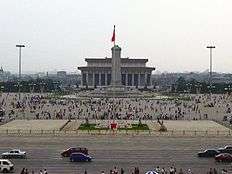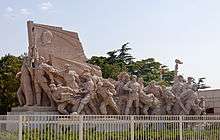Mausoleum of Mao Zedong
Coordinates: 39°54′04″N 116°23′29″E / 39.9010°N 116.3915°E
.jpg)
The Chairman Mao Memorial Hall (simplified Chinese: 毛主席纪念堂; traditional Chinese: 毛主席紀念堂; pinyin: Máo Zhǔxí Jìniàn Táng), commonly known as the Mausoleum of Mao Zedong, is the final resting place of Mao Zedong, Chairman of the Politburo of the Communist Party of China from 1943 and the Chairman of the Communist Party of China from 1945 until his death in 1976.
Although Mao had wished to be cremated, his body was embalmed and construction of a mausoleum began shortly after his death. This highly popular attraction is located in the middle of Tiananmen Square in Beijing, the capital of China. It stands on the previous site of the Gate of China, the southern (main) gate of the Imperial City during the Ming and Qing dynasties.
The remains of the Great Helmsman, as he is sometimes known, are on display for public viewing (though some claim this is a wax sculpture placed over the actual body).[1] People line up for hundreds of meters every day to see the former chairman, many paying tribute to him with flowers that can be purchased at the entrance on the north side. There is a souvenir shop at the exit on the south side.
Construction


The mausoleum was built soon after Mao's death on September 9, 1976. The groundbreaking ceremony took place November 24, 1976 and the mausoleum was completed on May 24, 1977. Hua Guofeng, who supervised the mausoleum project, has his handwriting on the mausoleum's sign.
People throughout China were involved in the design and construction of the mausoleum, with 700,000 people from different provinces, autonomous regions, and nationalities doing symbolic voluntary labour.[2] Materials from all over China were used throughout the building: granite from Sichuan province, porcelain plates from Guangdong province, pine trees from Yan'an in Shaanxi province, saw-wort seeds from the Tian Shan mountains in the Xinjiang Autonomous Region, earth from quake-stricken Tangshan, colored pebbles from Nanjing, milky quartz from the Kunlun Mountains, pine logs from Jiangxi province, and rock samples from Mount Everest. Water and sand from the Taiwan Straits were also used to symbolically emphasize the People's Republic of China's claims over Taiwan. The mausoleum was closed for renovations for nine months in 1977 before reopening on September 20.[3]
Crystal coffin
In the wake of the Sino-Soviet split, the Soviet process of embalming had to be learned through Vietnam and a crystal coffin for displaying the body had to be locally developed. An initial proposal was to use the crystal coffin the USSR had provided Sun Yat-sen after his death in 1925, though this proved unfeasible because the coffin's length (1.75 metres (5 ft 9 in)) was not sufficient for Mao's height (1.8 m (5 ft 11 in)) and the nickle-plated sides would have necessitated having visitors look down on Mao's body (which was deemed unacceptable by the authorities). Projects to locally develop a crystal coffin were distributed under code names to enterprises all over China, including the 603rd factory, the 605th factory, the 608th factory (a noted maker of quality lenses, including those of Mao's spectacles and magnifying glasses), and the Beijing General Glass Factory.
One of the vital materials in the production of crystal coffins, the quartz crystals used to make quartz glass, had to be obtained from the East China Sea because of the rarity of quartz in mainland China (and the lack of any quality crystals of necessary size in the world). When the excavated quartz powder was processed, an issue arose from the fact that such large pieces of quartz glass would require three years of gradual cooling to remove any internal stress. Xu Zhaocai (徐兆采), a senior technician of the 605th Factory, solved this problem by developing a technique of welding twenty square centimeter pieces into a larger two square meter plate. This was carried out by a senior technician named Shi Weicheng (石维成), who used a hydrogen-oxygen flame gun to reach the necessary temperatures of nearly 2,000 °C (3,630 °F) (even the metallic protective gear Shi wore proved vulnerable to the heat and he had other workers pour water onto him to keep him cool). To grind down the 100 mm (3.9 in) crystal plates to the specified 45 mm (1.8 in), the 608th factory staff had to use a single West German 2 metres (6.6 ft) precision grinding machine and eight planer-type milling machines in the Beijing First Machine Tool Factory.
The issue of illuminating the coffin was dealt with in a simultaneous project, with Ren Fuguang (任夫广) as its manager and optical engineer Li Jiaying (李家英) as the chief designer. Using a ten-year-old specimen provided by Beijing Medical University, they were able to work out a harmonization of colors, angles, and intensity that gave the appearance of normal skin tone (instead of the original gray) and reduced visible wrinkles. After evaluating numerous designs, a system of xenon lamps designed by Cai Zuquan (蔡祖泉) was chosen, which would be installed inside the coffin (hidden from visitors' views) and use fiber optics to provide the same lighting, even if one of the lamps were extinguished. Optical engineer Wang Daheng (王大珩) was enlisted to devise the proper angles for the coffin, preventing any reflections and helping it maintain its structural integrity. The precision of the work meant the plates would not collapse, even without any adhesives or other methods of connection, and give it a dimensional tolerance of up to 10 µm (0.00039 in).
Nearly two dozen crystal coffins from all over China were also there for the competition, including six from Shanghai and one from Sichuan (which featured a circular shape and red carpet inside, reminiscent of Mao's symbol of the red sun during the Cultural Revolution). The design of the 608th factory, after being subject to various environmental tests (including for temperature, vibration, and an 8.0-magnitude earthquake), was selected on the spot as Mao's crystal coffin.
Visits
Mao Zedong's surviving family members always visit the mausoleum biannually on Mao's birthday and the day he died. According to one of Mao's granddaughters, Kong Dongmei (孔东梅), Mao's third wife He Zizhen was initially banned from visiting the mausoleum, for reasons never explained by the Chinese government. After more than a year of repeated appeals and by which time nearly two million people had already visited the mausoleum, she was finally allowed a single secret visit with heavy restrictions: she was not allowed to cry or make any noise inside or to talk to the press about the visit. She was allowed to be photographed with her ex-husband's statue in the mausoleum by Lu Xiangyou (吕相友), Mao's personal photographer since the late 1950s.
Xu Jing (徐静), one of the designers involved in the mausoleum's construction, later wrote about the process in The Place Where a Great Man Rests as well as listing the visits of important people to the mausoleum. However, his own visit on September 8, 1979 was barred from the book, by order of the Chinese government, again for reasons never explained.
See also
- National Chiang Kai-shek Memorial Hall
- Lenin's Mausoleum
- Sun Yat-sen Mausoleum
- Cihu Mausoleum
- Touliao Mausoleum
- Ho Chi Minh Mausoleum
- Kumsusan Palace of the Sun
- House of Flowers (mausoleum)
- Sükhbaatar's Mausoleum
- Georgi Dimitrov Mausoleum
- National Monument in Vitkov
- Valle de los Caídos
- Alley of Honor
- Türkmenbaşy Ruhy Mosque
- Kwame Nkrumah Mausoleum
- Mausoleum of Khomeini
- Julius Nyerere's mausoleum in Butiama Cemetery
- Marcos Museum and Mausoleum
- Babaoshan Revolutionary Cemetery
References
Citations
- ↑ "The embalming: Mao died at 12.10 am on 9 September 1976. Zhisui Li, Mao's doctor for 22 years, immediately faced a new challenge – the order to preserve the body for ever. Rumour has it that the body now on show in Tiannamen Square is wax; but communiques from the Mao Memorial Hall reassure us it is real". The Independent. October 8, 1994. Retrieved 2012-02-19.
- ↑ "The Chairman Mao Memorial Hall Successfully Completed", China Pictorial, 9: 4–12, 1977
- ↑ "Crowds flock to Mao mausoleum". BBC. 1-6-1998. Retrieved 2013-12-31. Check date values in:
|date=(help)
Sources
- Lothar Ledderose: "The Mausoleum for Mao Zedong – An Example of Political Architecture". In: Tilemann Grimm, Peter M. Kuhfus, Gudrun Wacker (Hrsg.), Collected Papers of the XXIXth Congress of Chinese Studies (= Werkhefte der Universität Tübingen, Reihe B: Geisteswissenschaften, 4). Tübingen: Attempto, 1988, p. 121–128.
External links
| Wikimedia Commons has media related to Mausoleum of Mao Zedong. |